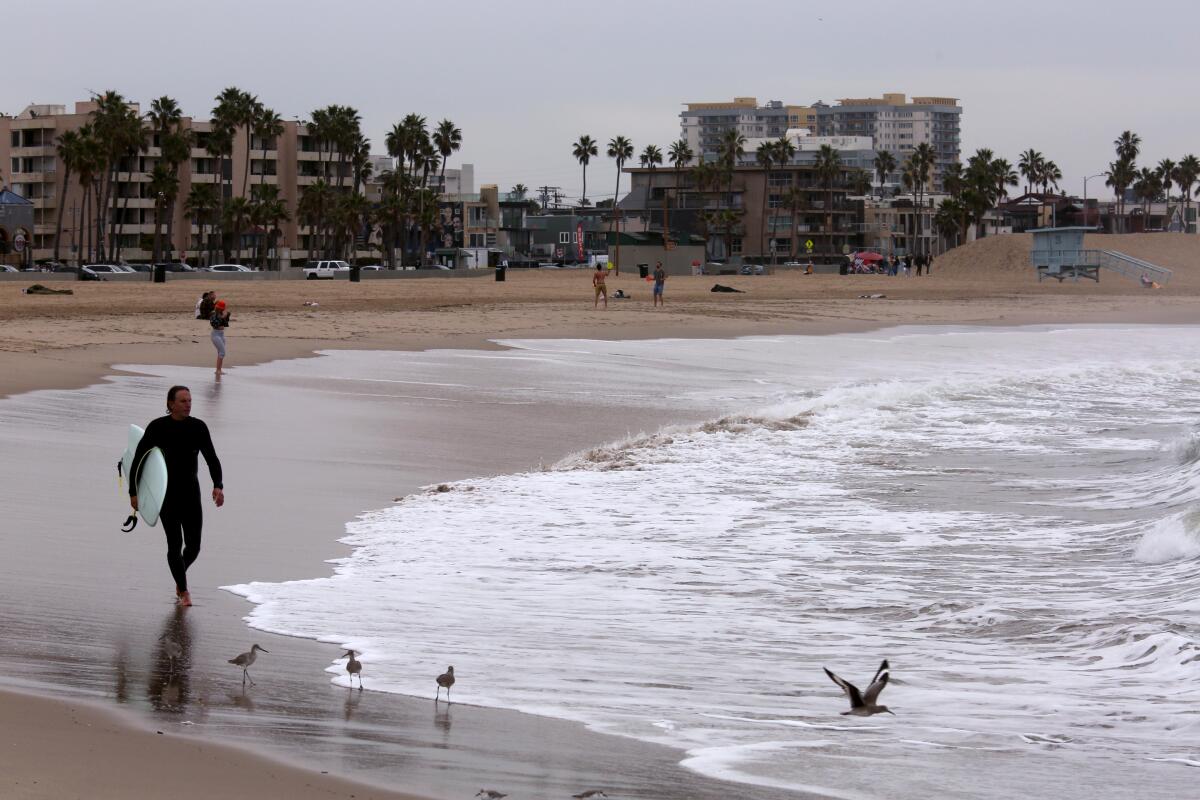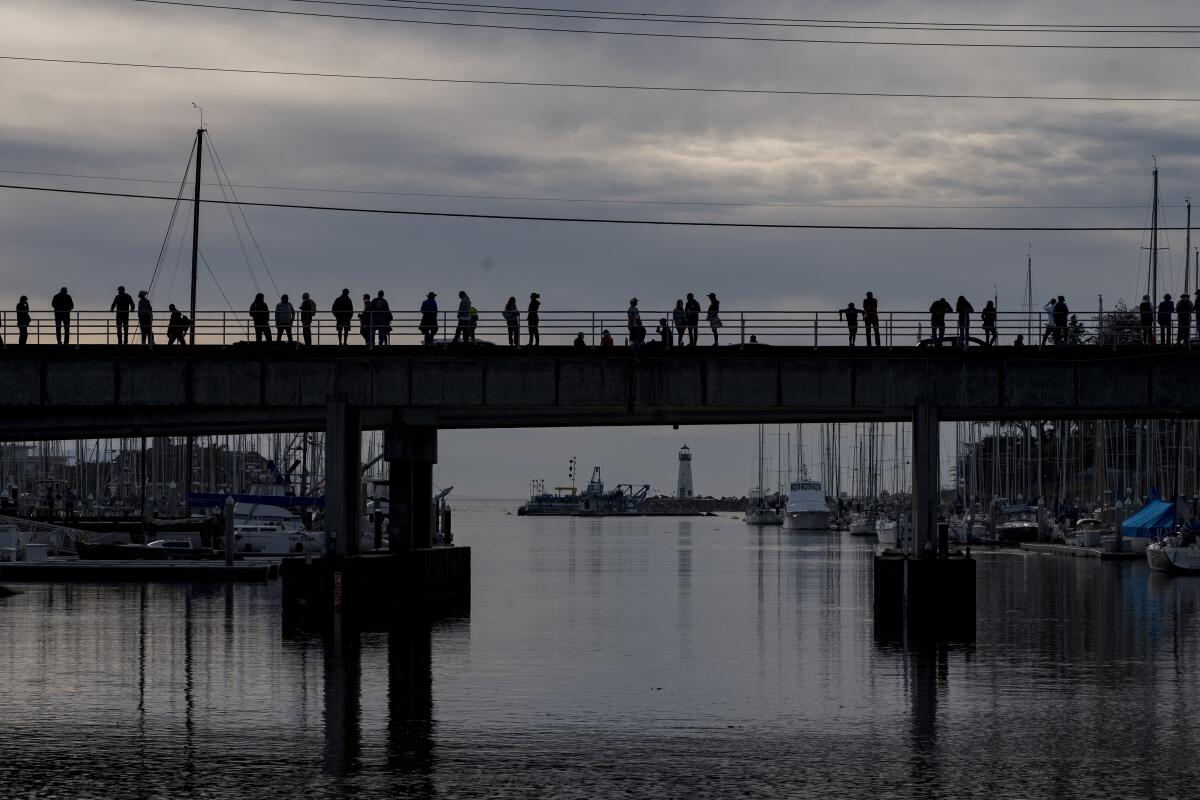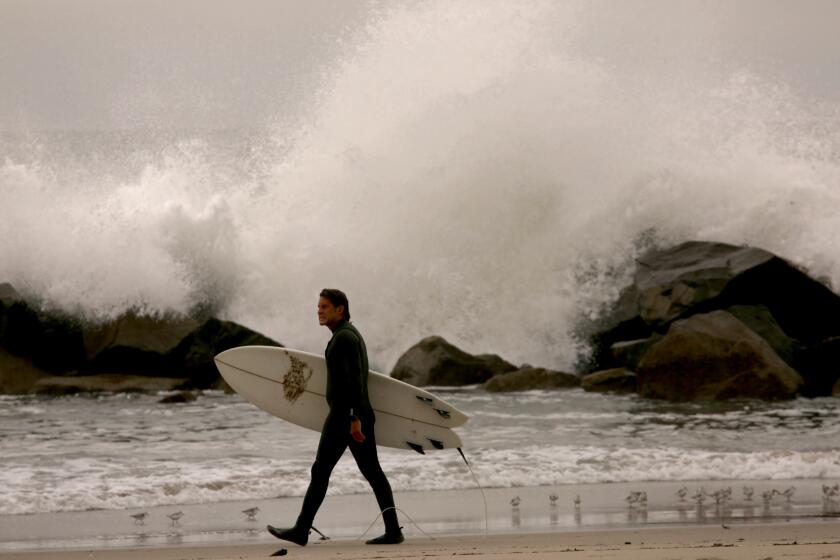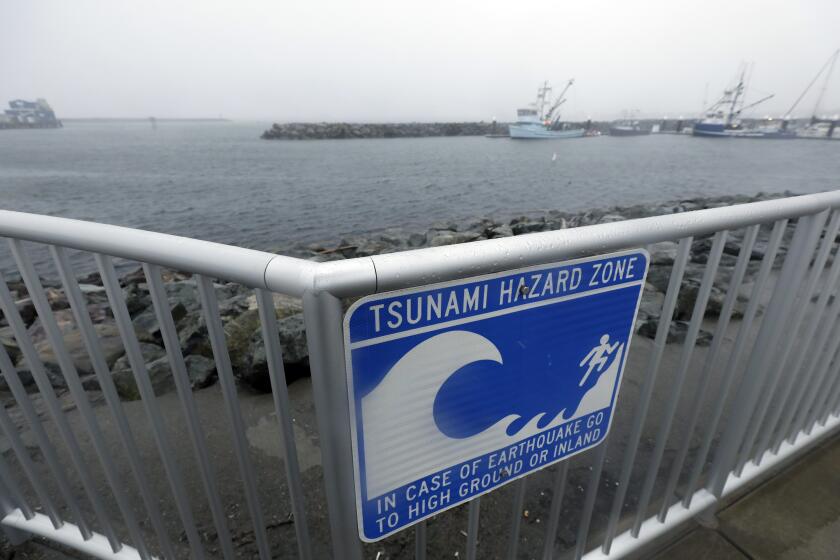Tsunami from Pacific volcano hits California coast with small waves, scattered flooding

- Share via
California tsunami advisories triggered Saturday morning by an underwater volcanic eruption near the South Pacific nation of Tonga had been largely lifted by 9 p.m. after authorities spent much of the day urging people to stay away from beaches and harbors and out of ocean waters churning with powerful currents.
The advisories were cancelled in coastal communities including those in Los Angeles, San Diego, Santa Cruz, San Francisco, and Newport and Huntington Beaches.
Many beaches and marinas from Orange County to the Bay Area were temporarily closed Saturday morning as a precaution because of higher than normal waves, officials said.
On Sunday, it was reported that two people drowned off the coast of northern Peru due to unusually high waves but elsewhere there were no reports of deaths, serious injuries or widespread property damage. The hardest-hit area of California appeared to be Santa Cruz Harbor, where the tsunami waves rushed in at high tide, flooding a parking lot and streets.
Kristan Lund, a National Weather Service meteorologist in Oxnard, distinguished the advisory issued Saturday morning from a more severe “warning,” in which residents are urged to evacuate to higher ground immediately.
“We are advising people to stay out of the water and off the beaches,” she said.
The hardest hit area of California appeared to be Santa Cruz Harbor where the tsunami waves rushed in at high tide, overflowing an embankment and flooding streets.
She said the advisory was “fairly uncommon” because it was due to a volcanic eruption and not an underwater earthquake, and because it extended to the entire West Coast. The entire coast was at risk, she said, including portions of islands that face away from the volcano, such as Avalon Harbor.
The water surge can “bend around the island and it can also bounce off the shores,” she said. As of 8:30 a.m., Port San Luis Harbor in San Luis Obispo County was registering a surge of more than 1 foot, she said.
Earlier Saturday, the National Weather Service said the tsunami activity was supposed to hit Monterey around 7:30 a.m. and San Francisco around 8:10 a.m. Beaches in Southern California were supposed to see impacts beginning around 7:50 a.m. Many beaches and piers were closed. Berkeley closed its marina and urged people to seek higher ground.
Officials said some coastal areas could see wave heights of 1 to 2 feet. The main impacts are expected to be strong rip currents and coastal flooding, and inundation of low lying areas is possible.
“If you are located in this coastal area,” NWS said, “move off the beach and out of harbors and marinas. Do not go to the coast to watch the tsunami. Be alert to instructions from your local emergency officials.”
The Orange County Sheriff’s Department said in a morning advisory that although major flooding was not expected, the tsunami could produce dangerous currents and tidal surges through the day that would make swimming hazardous. Strong currents were expected in harbors and bays for several hours.
“The ocean is rather calm right now,” said Seal Beach Police Lt. Nick Nicholas shortly after 10 a.m.
Officers and lifeguards were patrolling the shore for signs of flooding and to keep people out of the water, Nicholas said. The city closed beaches, parking lots and the pier before sunrise and few surfers or swimmers were out at that hour, he said.
California is hit by about one tsunami a year, but most are barely noticeable. That said, if you live or work near the water or ever visit the coast, you should know what to do if there’s a big earthquake or a tsunami warning.
“Fortunately we got there pretty early … and I don’t think we had to chase anybody away,” Nicholas said.
Newport Beach also appeared at mid-morning to have escaped damage with the surge remaining below a foot and no sign of flooding, according to the Sheriff’s Department.
Harbor patrols and local authorities were going boat to boat on the water to warn mariners about remaining dangers from the tsunami.
“The major point of concern is for currents, particularly strong riptide currents,” said Carrie Braun, the sheriff’s director of public affairs and community engagement.
Newport Beach resident Bob Baeyens, 61, was surprised to run into a locked gate halfway along the pier.
“I’ve never seen it closed off this way. But then you usually don’t get word of tsunami danger, not really here,” he said, looking below at surfers flocking to the shimmering waters.
“They’re still coming,“ he added, pointing toward the bobbing bodies in wetsuits, which he estimated at about 100.
Baeyens said his son alerted him about the undersea volcano near Tonga, texting him pictures. During his beach walk around 11 a.m. Saturday, he noticed higher than normal waves.
“We’re a long way from that volcano, yet things can connect,” he said. “I just don’t think it will affect the amount of people coming to the beach because we all like Southern California for a reason. I mean, just the other day it was 81 degrees in January — yeah, January — there’s only a few places in the world where that can happen.”
Monica Chan and her family left their home in Bakersfield at 7 a.m. Saturday, heading to Newport Beach for a day of relaxation. By late morning, her husband was still waiting for access to the city’s pier to cast his pole, as he was hoping to catch their dinner.
Despite the advisory, Chan said her family planned to enjoy their day.
“We didn’t know about the tsunami,” she said. “We would have come anyway.”
Los Angeles County officials issued the following advisory for coastal areas:
- Move out of the water, off the beach, and away from harbors, marinas, breakwaters, bays and inlets.
- Do not go to the shore to observe the tsunami.
- Do not return to the coast until local emergency officials indicate it is safe.
Some Southern California beachgoers took it all in stride. As a light rain fell, it seemed like a typical Saturday morning at Venice Beach as joggers ran along Ocean Front Walk and surfers caught waves at the pier and breakwater. County parking lots and the pier were open.
People were aware of the tsunami advisory but said they weren’t going to let that ruin their plans.
“We were hoping for a little bump [in the surf size], but that didn’t happen,” said Glen Alder, 58, as he peeled off his wetsuit at the Venice Pier. He and several friends caught 2- to 3-foot waves on the north side of the pier.
David Solomon, 52, also didn’t let the advisory stop him from getting into the water.
“I’m either going to get destroyed by Omicron or go out here,” said Solomon, as he put on his wetsuit and looked toward the waves lining up at the Venice breakwater.
For Solomon, his biggest worry wasn’t a tsunami but which of his two short boards he was going to use.
“I thought it was so funny that I grabbed a screenshot for my friends,” he said of the tsunami advisory on his phone.
Venice resident Damon Tolstoy said he was being extra careful as he walked Bubba, his British bulldog, on the Venice Pier.
“You just gotta be on alert,” he said of the advisory. “You never know.”
Farther north, the surge swept into Santa Cruz Harbor early Saturday, causing flooding and jostling boats, said Ashley Keehn, public information officer for the Santa Cruz County Sheriff’s Office. Deputies and the Harbor Patrol evacuated people from the harbor, including some people who live aboard boats.

“We went boat to boat evacuating the docks and making sure there wasn’t anyone inside that could potentially be in danger,” Keehn said.
The water level rose several feet in the harbor, she said.
“There have been some minor waves rolling in,” Keehn said. “We have seen some boats getting knocked around a little bit.”
One car was submerged in seawater up to the tops of the tires, she said. No injuries were reported.
The authorities planned to assess any damage once the water receded, Keehn said. “With the water still being a pretty high level, it’s hard to assess the damage right now.”
Gordon Rudy, a Realtor who keeps a 28-foot cabin cruiser boat at the harbor’s U-Dock, watched the surge from the harbor parking lot after being evacuated and said, “There are no boats being damaged at this point.”
A decade ago, a tsunami caused by a Japanese earthquake left the harbor with damage estimated in excess of $20 million. People present for both events said Saturday’s surge was relatively mild.
“We saw very little debris floating in the channel. Nothing compared to 2011,” said contractor Scott Sommers, who spent the night on his 32-foot power boat to be ready for early morning crabbing. When the tsunami advisory was issued before dawn, boat owners roused sleeping neighbors.
Some opted to take their boats out of the harbor to the open sea for safety while others decided to leave their vessels in place and watch from land or a railroad bridge overlooking the harbor. The surge arrived shortly after 8 a.m., they said, and was markedly different from the violent waves of the 2011 tsunami.
“There were no big waves. It would just surge in and surge back out,” Sommers said. He and Rudy estimated the water rose quickly as much as 8 feet and then flowed out just as rapidly.
“Like high tide and low tide happened in two or three minutes,” Sommers said.
While the boats seemed to survive the surge, water breached the embankment, flooding parking lots and streets. As of 11 a.m. the harbor remained closed and inaccessible to owners to inspect boats for damage.
Rudy, whose boat had nearly $30,000 in damage in the 2011 tsunami, said he purchased a new boat in October and was relieved that it appeared to have escaped harm.
“You have an absolutely perfect boat; you hope you can keep it that way,” he said.
The surge of seawater almost reached some Santa Cruz streets, and police said they had closed Beach Street as a precaution.
“It’s since receded but we’re still seeing occasional surges,” Deputy Police Chief Jon Bush said. Police officers were in the area making sure people stayed off the beach, he said, just in case the water surged higher again.
Dustin Mulvaney, a professor of environmental studies at San Jose State University who lives in Santa Cruz, shared short video clips on Twitter of the waves sloshing against the cliffs and inundating steps on the shore.
“The waves are just coming from everywhere, it seems like,” Mulvaney said. “The water’s bouncing around a lot.”
The tsunami swell coincided with a high tide, and the breakers sloshed about 15 feet above the sand onto the stairs at Mitchell’s Cove Beach, Mulvaney said.
Mulvaney said he walks along West Cliff Drive every day, often with his two kids and walking the dog. The waves were some of the biggest he’s seen in the last year, but no surfers were out in the water. This time, he said, the waves looked different.
“It definitely is choppy,” Mulvaney said. “You’re not able to read these waves because they’re coming from different angles.”
Between wave sets, the water receded unusually far, posing potential danger for any unsuspecting people who might venture down onto the beaches, Mulvaney said. “That’s why I stayed up on the cliff.”
Beyond the immediate hazards in the harbor and elsewhere, Mulvaney said looking at the crashing waves made him think about the need to prepare for sea-level rise and worsening storm surges.
“We have areas prone to earthquakes and fires, and just having a tsunami added on top of all that,” he said, “makes you realize that we all live in kind of vulnerable places.”
National Weather Service meteorologist Brian Garcia said in a morning briefing that surges along the California coast were expected to continue throughout “the vast majority of the daylight hours.”
“But we should see the amplitude start to come down as we get into the afternoon and late afternoon hours,” he said. When the surge falls below 1 foot and remains there for three hours, the advisory will be lifted, he said.
Officials at the National Tsunami Warning Center in Palmer, Alaska, issued Saturday’s tsunami alert after tracking the surge of water in Tonga, American Samoa and finally Hawaii, where it was measured at more than 2 feet.
“Our teams have been watching the entire time,” said Dave Snider, the center’s tsunami warning coordinator. “This is a really significant event.”
He said the tsunami is markedly different — and possibly unprecedented — than previous alerts because it was caused by a volcano rather than an earthquake. That made it hard to predict the effects and their duration, he said, as waves “sloshed” around harbors and jostled live-aboard boats.
Shortly before 9 a.m., the highest surge recorded was more than 2 feet in Monterey, he said.
In Hawaii, the Pacific Tsunami Warning Center reported waves slamming ashore from a foot in Nawiliwili, Kauai, to 2.7 feet in Hanalei. “We are relieved that there is no reported damage and only minor flooding throughout the islands,” the center said, describing the situation in Hawaii.
On Tonga, video posted to social media showed large waves washing ashore in coastal areas, swirling around homes and buildings.
In Hawaii, Alaska and along the U.S. Pacific coast, residents were asked to move away from the coastline to higher ground and pay attention to specific instructions from their local emergency management officials, said Dave Snider, tsunami warning coordinator for the National Tsunami Warning Center in Palmer, Alaska.
“We don’t issue an advisory for this length of coastline as we’ve done — I’m not sure when the last time was — but it really isn’t an everyday experience,” he said. “I hope that elevates the importance and severity for our citizens.”
The Associated Press contributed to this report.
More to Read
Sign up for Essential California
The most important California stories and recommendations in your inbox every morning.
You may occasionally receive promotional content from the Los Angeles Times.












